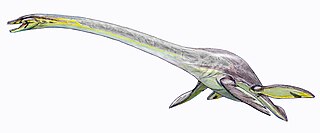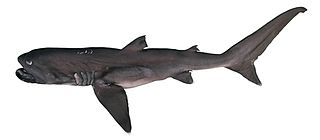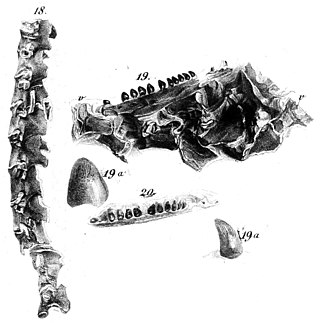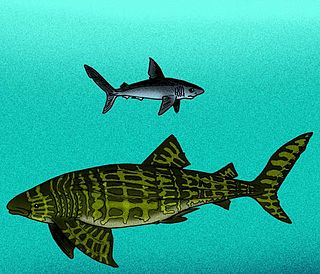
Plesiosauroidea is an extinct clade of carnivorous marine reptiles. They have the snake-like longest neck to body ratio of any reptile. Plesiosauroids are known from the Jurassic and Cretaceous periods. After their discovery, some plesiosauroids were said to have resembled "a snake threaded through the shell of a turtle", although they had no shell.

The megamouth shark is a species of deepwater shark. Rarely seen by humans, it measures around 5.2 m (17 ft) long and is the smallest of the three extant filter-feeding sharks alongside the relatively larger whale shark and basking shark. Since its discovery in 1976, fewer than 100 specimens have been observed or caught. Like the other two planktivorous sharks, it swims with its mouth wide open, filtering water for plankton and jellyfish. It is recognizable from its large head with rubbery lips. The megamouth is so unlike any other type of shark that it is usually considered to be the sole extant species in the family Megachasmidae, though some scientists have suggested it may belong in the family Cetorhinidae.

Cretoxyrhina is an extinct genus of large mackerel shark that lived about 107 to 73 million years ago during the late Albian to late Campanian of the Late Cretaceous. The type species, C. mantelli, is more commonly referred to as the Ginsu shark, first popularized in reference to the Ginsu knife, as its theoretical feeding mechanism is often compared with the "slicing and dicing" when one uses the knife. Cretoxyrhina is traditionally classified as the likely sole member of the family Cretoxyrhinidae but other taxonomic placements have been proposed, such as within the Alopiidae and Lamnidae.

Ichthyornis is an extinct genus of toothy seabird-like ornithuran from the late Cretaceous period of North America. Its fossil remains are known from the chalks of Alberta, Alabama, Kansas, New Mexico, Saskatchewan, and Texas, in strata that were laid down in the Western Interior Seaway during the Turonian through Campanian ages, about 95–83.5 million years ago. Ichthyornis is a common component of the Niobrara Formation fauna, and numerous specimens have been found.

Megachasma is a genus of mackerel sharks. It is usually considered to be the sole genus in the distinct family Megachasmidae, though suggestion has been made that it may belong in the family Cetorhinidae, of which the basking shark is currently the sole extant member. Megachasma is known from a single living species, Megachasma pelagios.

Dolichorhynchops is an extinct genus of polycotylid plesiosaur from the Late Cretaceous of North America, containing the species D. osborni and D. herschelensis, with two previous species having been assigned to new genera. Dolichorhynchops was a prehistoric marine reptile. Its Greek generic name means "long-nosed face". While typically measuring about 3 metres (9.8 ft) in length, the largest specimen of D. osborni is estimated to have a total body length more than approximately 4.29 metres (14.1 ft).

Protostegidae is a family of extinct marine turtles that lived during the Cretaceous period. The family includes some of the largest sea turtles that ever existed. The largest, Archelon, had a head one metre (39 in) long. Like most sea turtles, they had flattened bodies and flippers for front appendages; protostegids had minimal shells like leatherback turtles of modern times.

Ptychodus is a genus of extinct durophagous (shell-crushing) sharks from the Late Cretaceous. Fossils of Ptychodus teeth are found in many Late Cretaceous marine sediments worldwide. Numerous species have been described. The youngest remains date to around 85 million years ago. A large number of remains have been found in the former Western Interior Seaway. A 2016 publication found that Ptychodus are likely true sharks belonging to Selachimorpha, rather than hybodonts or batoids as previously thought. Their life history coincides with the typical life of many other large sharks: they lived relatively long lives and were slow growing and produced large offspring and small litters.

The Pierre Shale is a geologic formation or series in the Upper Cretaceous which occurs east of the Rocky Mountains in the Great Plains, from Pembina Valley in Canada to New Mexico.

During the time of the deposition of the Niobrara Chalk, much life inhabited the seas of the Western Interior Seaway. By this time in the Late Cretaceous many new lifeforms appeared such as mosasaurs, which were to be some of the last of the aquatic lifeforms to evolve before the end of the Mesozoic. Life of the Niobrara Chalk is comparable to that of the Dakota Formation, although the Dakota Formation, which was deposited during the Cenomanian, predates the chalk by about 10 million years.

The Carlile Shale is a Turonian age Upper/Late Cretaceous series shale geologic formation in the central-western United States, including in the Great Plains region of Colorado, Kansas, Nebraska, New Mexico, North Dakota, South Dakota, and Wyoming.

Bonnerichthys is a genus of fossil fishes within the family Pachycormidae that lived during the Coniacian to Maastrichtian stage of the Late Cretaceous. Fossil remains of this taxon were first described from the Smoky Hill Member of the Niobrara Chalk Formation of Kansas, and additional material was later reported from the Pierre Shale, Mooreville Chalk, Demopolis Chalk, Wenonah Formation, and Moreno Formation, among other localities. It grew to at least 5 metres (16 ft) in total body length, substantially less than the related Leedsichthys from the Jurassic which likely grew up to 16.5 metres (54 ft).

During most of the Late Cretaceous the eastern half of North America formed Appalachia, an island land mass separated from Laramidia to the west by the Western Interior Seaway. This seaway had split North America into two massive landmasses due to a multitude of factors such as tectonism and sea-level fluctuations for nearly 40 million years. The seaway eventually expanded, divided across the Dakotas, and by the end of the Cretaceous, it retreated towards the Gulf of Mexico and the Hudson Bay. This left the island masses joined in the continent of North America as the Rocky Mountains rose. From the Cenomanian to the end of the Campanian ages of the Late Cretaceous, Appalachia was separated from the rest of North America. As the Western Interior Seaway retreated in the Maastrichtian, Laramidia and Appalachia eventually connected. Because of this, its fauna was isolated, and developed very differently from the tyrannosaur, ceratopsian, hadrosaurid, pachycephalosaur and ankylosaurid dominated fauna of the western part of North America, known as "Laramidia".

Cretalamna is a genus of extinct otodontid shark that lived from the latest Early Cretaceous to Eocene epoch. It is considered by many to be the ancestor of the largest sharks to have ever lived, such as Otodus angustidens, Otodus chubutensis, and Otodus megalodon.

Megacephalosaurus is an extinct genus of short-necked pliosaur that inhabited the Western Interior Seaway of North America about 94 to 93 million years ago during the Turonian stage of the Late Cretaceous, containing the single species M. eulerti. It is named after its large head, which is the largest of any plesiosaur in the continent and measures up to 1.75 meters (5.7 ft) in length. Megacephalosaurus was one of the largest marine reptiles of its time with an estimated length of 6–9 meters (20–30 ft). Its long snout and consistently sized teeth suggest that it preferred a diet of smaller-sized prey.

Coniasaurus is an extinct genus of Late Cretaceous marine squamates that range in age from Cenomanian to Santonian. It was first described by Richard Owen in 1850 from lower Cenomanian chalk deposits in southeast England (Sussex). Two species have been described from this genus: C. crassidens, known from Cenomanian to Santonian deposits from southeast England, Germany and North America, and C. gracilodens from the Cenomanian of southeast England.
Pseudomegachasma is an extinct genus of filter-feeding shark that was closely related to the modern sand tiger shark. It is known from Cretaceous strata in Russia and the United States, and is the only known planktivorous odontaspid, as well as the oldest known planktivorous elasmobranch. It most likely derived from its closest relative, the piscivorous shark Johnlongia. As its name suggests, it was originally classified under Megachasma, before it was found to be an odontaspid.

Eorhincodon is an invalid genus of requiem shark from the Late Eocene of Xinjiang, China, originally described as a whale shark. It is currently considered a junior synonym of Rhizoprionodon. The genus was originally erected by Li (1997) to include the species Eorhincodon tianshanensis, but Nessov (1999) used the preoccupied genus in a different paleontological context to include an unrelated species, E. casei, from Late Cretaceous Russian marine strata. A new genus, Pseudomegachasma, was erected in 2015 for E. casei to be transferred into.

Cretodus is an extinct genus of large mackerel sharks belonging to the proposed family Pseudoscapanorhynchidae. Cretodus lived during the Late Cretaceous, ranging from the Cenomanian to the Coniacian. The genus is well-known from strata deposited in the Western Interior Seaway, and from the Late Cretaceous of Europe, Africa, and possibly Asia. Cretodus is primarily represented in the fossil record by isolated teeth and vertebral centra, though a couple of associated dentitions and vertebral columns have been found.
Platylithophycus is an extinct genus of elasmobranchs that lived during the Late Cretaceous. It is known from a single specimen from the Niobrara Formation of Kansas, United States. It was originally identified as the fronds of a codiacean alga, then later as the cuttlebone of a cuttlefish. It was most recently reidentified as the gill arches and rakers of an elasmobranch of uncertain affinities. It might have been a filter feeding mackerel shark related to Aquilolamna.

















